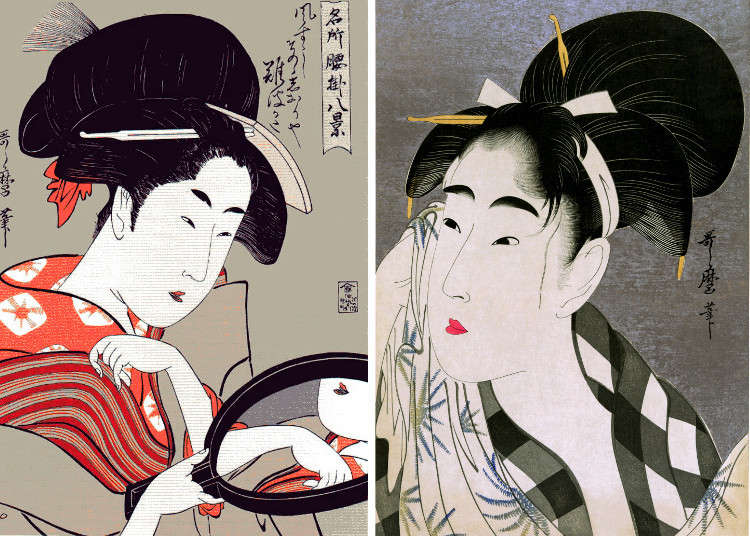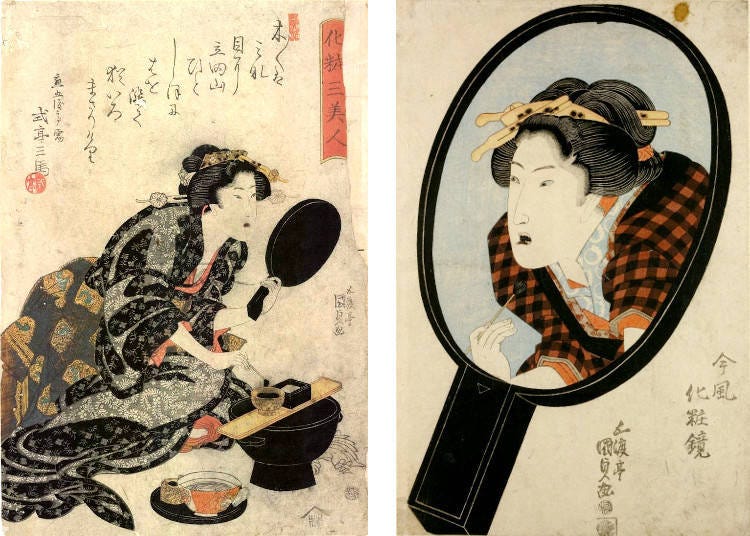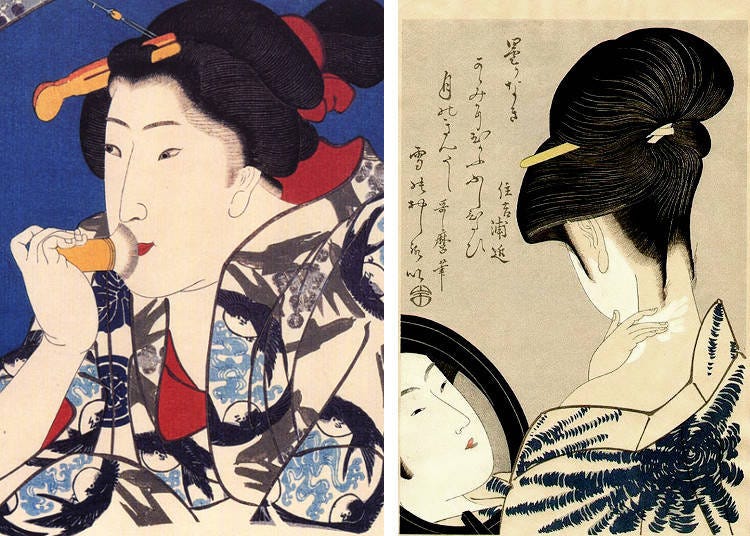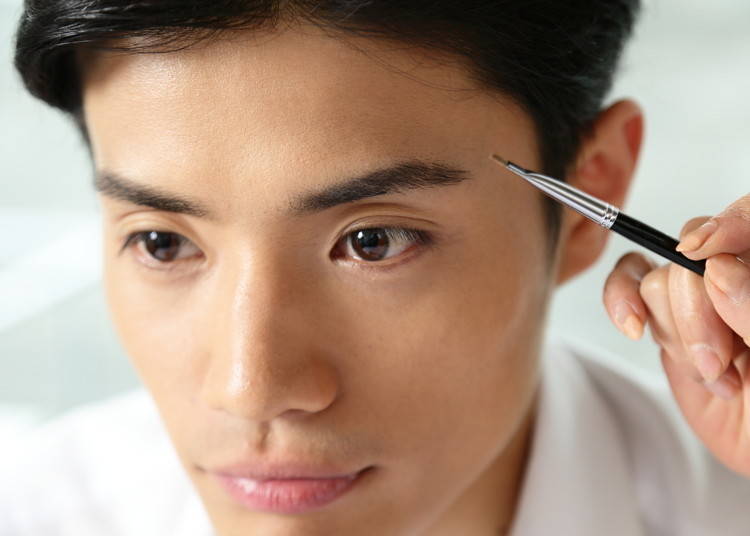How Long Men Wore Makeup In Japan In Early Years

Ruddy Lips, White Face: The Cultural History of Japanese Dazzler
Date published: 10 July 2017
Last updated: 4 Jan 2019
Have you e'er wondered near the development of Japanese beauty ethics that we see today? Although the trends accept vastly inverse, the mod look of Japanese fashionistas has its root buried deep into Japanese history.
The chronicles chosen kojiki ("Records of Aboriginal Matters") and nihon shoki (the second oldest book of classical Japanese history) reveal that even in ancient times, specific beauty customs such as of painting the face with blood-red pigments did already exist. Various forms of makeup - such equally cheek colors and facial powders - were imported into Nihon, along with other cultural aspects from Mainland china and Korea. It is said that the first Japanese face powder was produced by a Buddhist priest. Apparently, he delighted the Japanese Empress with his newest invention and then much that he set the trend for what should presently become one of the biggest corrective markets in the world.
Black Teeth as a Symbol of Beauty and Liberty

Utagawa Kunisada
During the Heian period (794-1185), Japanese beauty products broke complimentary from the influence of Chinese models and created a more distinct aesthetic of its own. This included directly long hair, white powdered faces, and repainted eyebrows. Despite this transformation, most make-up remained just available to the world of the elite. Virtually the same time, a quite unusual beauty ideal gear up foot in Japan - the blackening of teeth, chosen ohaguro.
Teeth, black as nighttime, were seen every bit beautiful and remained popular as a beauty ideal until the 19th century. Many Westerners who visited Japan described ohaguro as a repugnant Japanese custom which disfigured Japanese women past making the women intentionally unattractive. However, many Japanese girls were allowed a relatively big degree of both social and sexual liberty, then it is much more likely that this social ritual is a commemoration of the determination of matured women.
The Beautiful Harmony of Red, White, and Blackness

Utagawa Kuniyoshi / Kitagawa Utamaro
Past the early Edo menses (1600-1868), the focus shifted onto detailed treatises on etiquette, which likewise included teachings on the acceptable way of using cosmetics. During this period, cosmetics by and large centered on a palette of three basic colors: ruby-red (lip rouge, fingernail polish), white (face up powder called oshiroi), and black (tooth-blackener, countenance pencil). The white face pulverisation was used to create a stark white complexion, oftentimes artfully contrasted to the natural shade of the surrounding skin with a carefully contoured edge at the lower cervix below the hairline. The lips were painted onto the white foundation and usually rendered smaller and slightly higher than the natural lip shape.
It was during this era when women were particularly concerned with the application of face powder in order to create a flawless complexion that was regarded every bit "the essence of a beautiful woman."
Although refinement and sensitivity where cherished traits when it came to the general application of make-up, a trend in the late Edo Period fabricated the use of heavier lipstick increasingly popular. Pigments that were produced from fresh safflowers became so expensive, information technology was said to be fifty-fifty worth its weight in gold.
Modern Aesthetics for Modern Beauty

Kiyoshi Kobayakawa
With the beginning of the 20th century, the focus shifted toward quick application and more than convenient brand-upwards practices that were in strong correlation with the advancement of women in society and, more than importantly, the workplace. Face pulverization and lipsticks began to exist sold in a broader range of shades other than the traditional white and ruby. Emulsions and variations of skincare products appeared on the market as the cosmetics manufacture became increasingly aware of the Western sphere of influence from the 1910's onward. Specially after World War Two, Japan's aesthetics became heavily influenced by Western mass media, especially American magazines and movies.
The Beauty of Old is the Beauty of Today

In present days, Nihon has been able to become one of the worldwide market place leaders for cosmetics and beauty products and has furthermore been able to firmly establish itself with miscellaneous innovations fabricated in the name of beauty.
Although the white heavy face up pulverization look of the Edo period doesn't agree truthful today and mainly survives in a re-enactment on phase, cute white peel is still a crucial beauty ideal for many Japanese. The leading advancements in scar tissue reduction techniques of the beauty industry are straight linked to the emphasis placed on unblemished pare - a beauty ideal that has been existent long before any Western influence touched the Japanese islands.
*This data is from the time of this article'southward publication.
*Prices and options mentioned are subject area to change.
*Unless stated otherwise, all prices include tax.

-

All-You-Tin can-Eat A5 Wagyu! We Gorged Ourselves at Ginza's Meat-Lovers Paradise
-

Old Actually Meets New in 'Hobo Shinjuku Norengai' - Shinjuku's Latest Izakaya Complex
-

Springtime Exclusive! Meridian vii Scenic Views of Cherry-red Blossoms With Trains Well-nigh Tokyo
-

Stay in Luxury Right past Tokyo - four All-inclusive Hotel Plans in the Kanto Region!
- #best ramen tokyo
- #what to buy in ameyoko
- #what to bring to nihon
- #new years in tokyo
- #best izakaya shinjuku
- #things to exercise tokyo
- #japanese nail trends
- #what to practise in odaiba
- #onsen tattoo friendly tokyo
- #daiso
- #best sushi ginza
- #japanese convenience store snacks
- #best yakiniku shibuya
- #japanese fashion civilisation
- #best japanese soft drinks
Source: https://livejapan.com/en/in-tokyo/in-pref-tokyo/in-tokyo_train_station/article-a0001292/
Posted by: millercrummon.blogspot.com



0 Response to "How Long Men Wore Makeup In Japan In Early Years"
Post a Comment